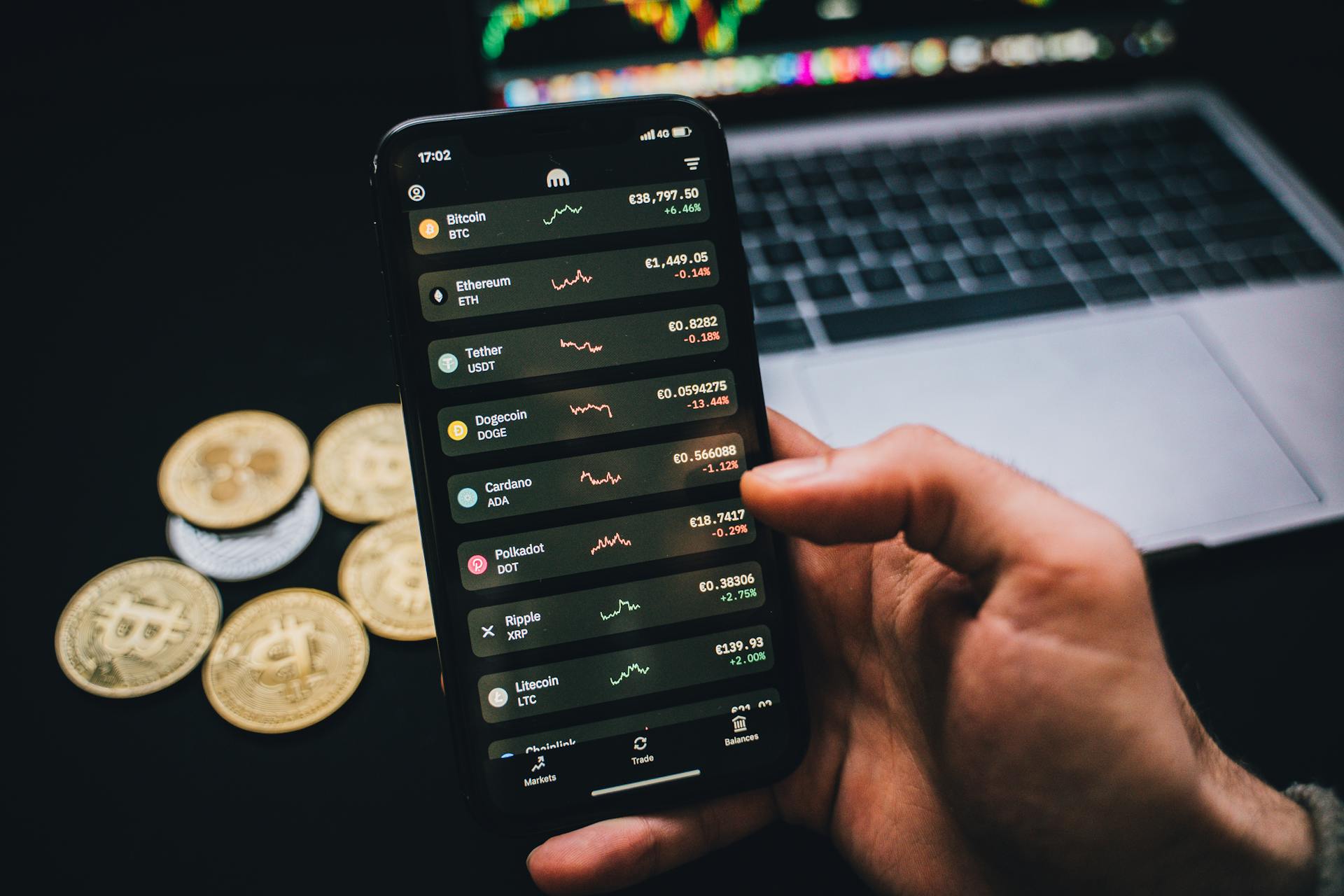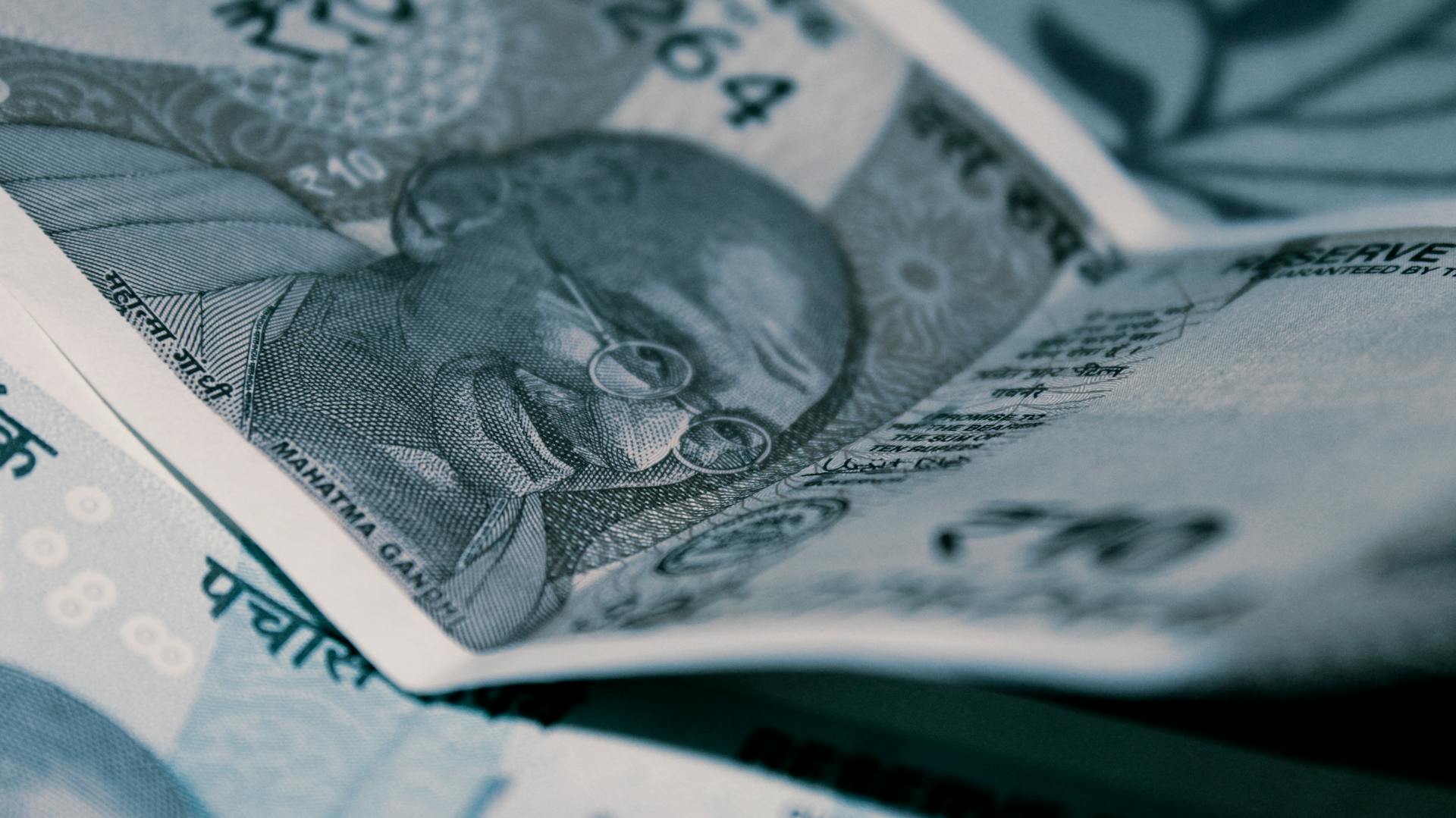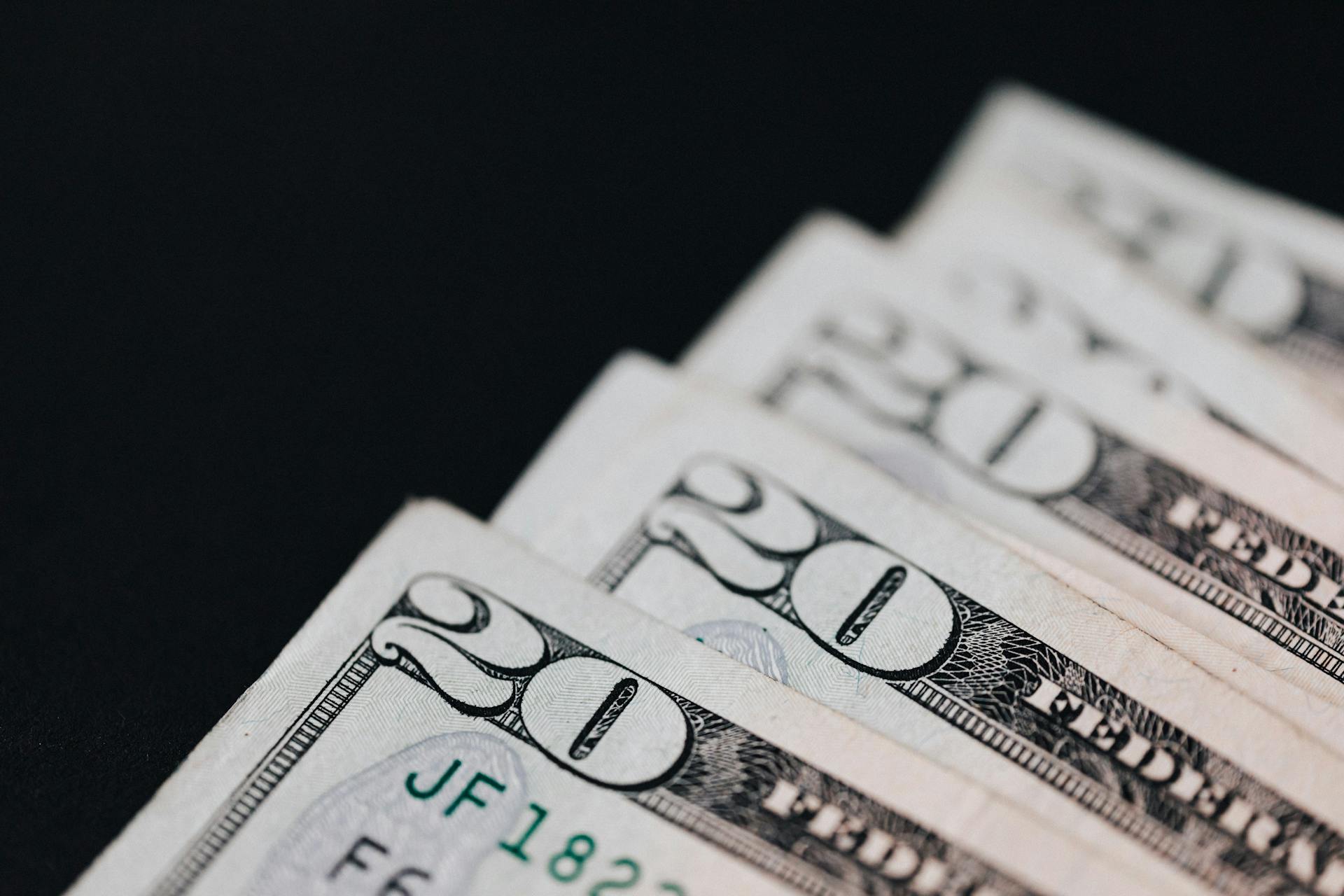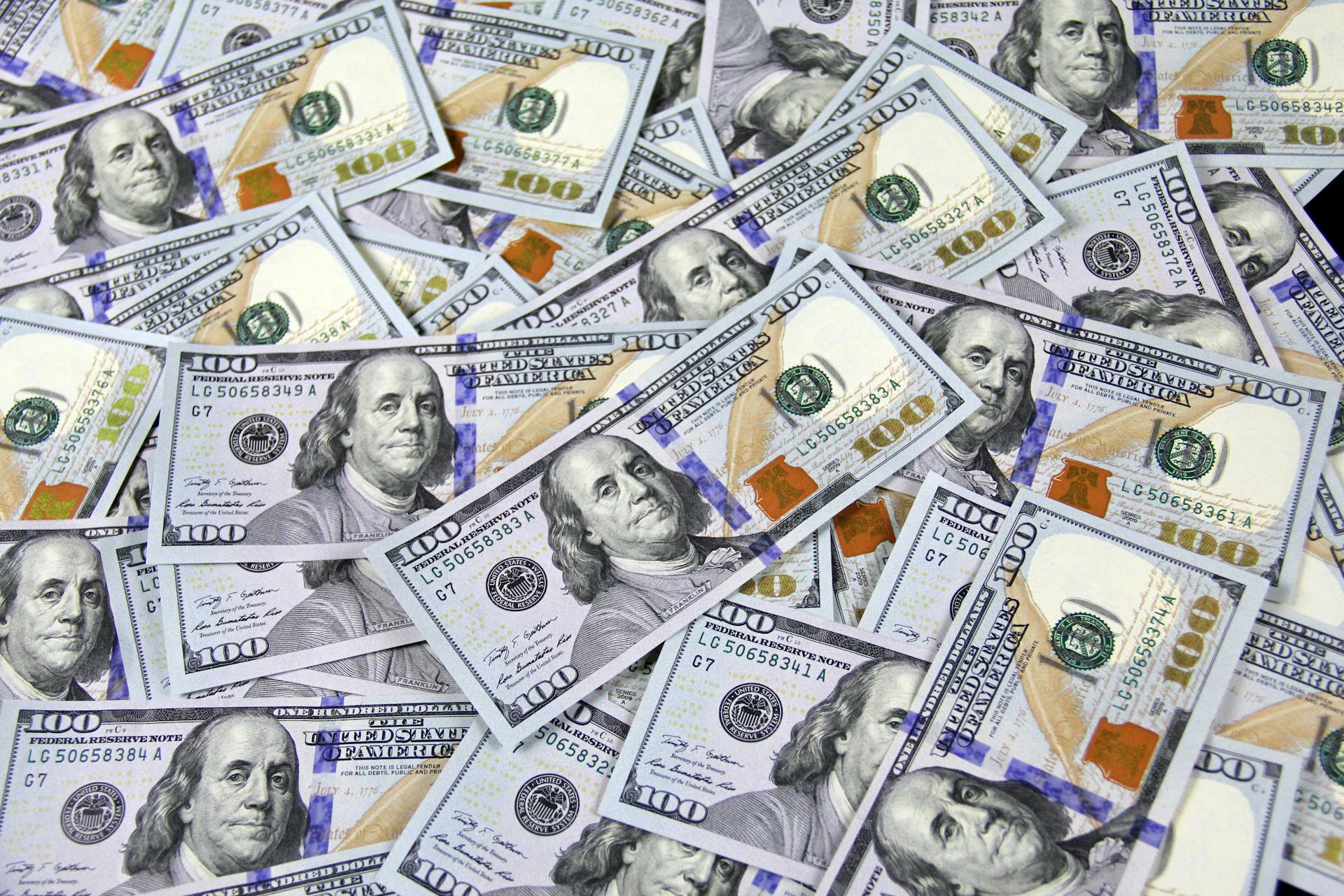
Options currency trading is a high-risk, high-reward game that requires a solid understanding of the market and the instruments involved.
Options trading involves buying and selling contracts that give the holder the right, but not the obligation, to buy or sell a currency pair at a specified price.
It's essential to have a clear understanding of the different types of options, including call options and put options, which allow you to speculate on the direction of the currency market.
The main advantage of options trading is that it allows you to control a large amount of currency with a relatively small amount of capital.
Options trading can be done through various platforms, including online trading platforms and mobile apps, making it accessible to traders from all over the world.
In the next section, we'll dive deeper into the mechanics of options trading and explore the various strategies that can be used to profit from it.
Broaden your view: Forex Day Trader
What Are Options?
Options in currency trading are derivative contracts that grant the holder the right, but not the obligation, to buy or sell a specific amount of one currency for another at a predetermined exchange rate (strike price) within a specified period.
These contracts are non-linear instruments used for both hedging and speculation purposes. They're widely utilized by individuals, corporations, and financial institutions to mitigate foreign exchange risk, speculate on currency fluctuations, and hedge international transactions.
The buyer of a currency option pays a premium to the seller/option writer to obtain this right. This premium is a cost of doing business in the currency options market.
Here are some key benefits of using currency options:
- Currency options offer opportunities to profit from favorable currency movements.
- They protect against adverse changes in currency exchange rates.
- They're used to mitigate foreign exchange risk and speculate on currency fluctuations.
Types of Options
There are two main types of currency options: European style and American style. European options can only be exercised at expiration, while American options can be exercised at any time before expiration.
Vanilla options are standard contracts with simple terms, while exotic options have more complicated designs and payouts. Vanilla options include basic call and put options, making it easy to hedge or guess currency changes.
The two main types of currency options are vanilla and exotic, serving different purposes in handling currency risk. Vanilla options are simple and clear, while exotic options offer specific solutions for complex risk situations.
Here are the main differences between vanilla and exotic options:
Call
A call option gives the holder the right to buy a currency at a fixed exchange rate. This type of option is entered into with the intent to benefit from an increase in the price of the currency pair.
The buyer of a call option can exercise their right to buy the currency pair at the pre-specified strike price on or before the expiry date of the contract. If the currency pair is below the strike price on expiry, the option ends worthless.
Investors buy calls when they think the share price of the underlying security will rise. The strike price is the price at which the option can be exercised, and it's usually set at a level that's attractive to the buyer.
Curious to learn more? Check out: Option Trading Stocks
For example, let's say an investor purchases a currency call option on the euro with a strike price of $115. If the euro's spot price at the expiration date is $118, the currency option is said to have expired in the money, and the investor's profit is $300.
Here are some key characteristics of call options:
- Provides the holder the right to purchase an underlying asset at a specified price (the strike price)
- Expires worthless if the stock fails to meet the strike price before the expiration date
- Investors buy calls when they think the share price of the underlying security will rise
The buyer of a call option has the right, but not the obligation, to exercise their option. This means they can choose to buy the currency pair at the strike price or let the option expire worthless.
Vanilla
Vanilla options are the foundation of options trading, and they're actually quite straightforward. They're simple contracts with clear terms, commonly traded on exchanges.
Vanilla options come in two main types: calls and puts. Calls give the holder the right to purchase an underlying asset at a specified price, while puts give the holder the right to sell an underlying asset at a specified price.
The strike price is a crucial part of vanilla options, as it determines the price at which the option can be exercised. If the stock fails to meet the strike price before expiration, the option expires worthless.
Here are the key characteristics of vanilla options:
- Call options: provide the holder the right to purchase an underlying asset at a specified price (the strike price)
- Put options: give the holder the right to sell an underlying asset at a specified price (the strike price)
Vanilla options are a great starting point for traders and investors, as they're easy to understand and offer a clear risk-return profile. They can be used for hedging or speculation, and are a popular choice for those new to options trading.
Understanding Options
Understanding options is crucial to navigating the world of currency trading. Options give the holder the right to buy or sell a currency at a specific price, known as the strike price, before a certain date, known as the expiration date.
A call option gives the holder the right to buy a currency, while a put option gives the right to sell. The strike price is set when the option is purchased and remains the same until expiration. The expiration date is the last day the option can be exercised.
Consider reading: What Is a Sell Stop Limit Order
Options can be used to speculate on currency movements or to hedge against potential losses. Hedging involves using options to protect against adverse currency movements, securing a known exchange rate for future transactions. Options are a useful tool for managing currency risk, but it's essential to understand the basics before diving in.
Here are the key concepts to keep in mind:
- Call option: gives the holder the right to buy a currency
- Put option: gives the holder the right to sell a currency
- Strike price: the price at which the option can be exercised
- Expiration date: the last day the option can be exercised
By understanding these basics, you'll be better equipped to navigate the world of currency options trading.
How It Works
A call option gives the holder the right to buy the currency pair at a specific price, known as the strike price. This is the exchange rate that is set when you buy the option, and it's the price you can use if you decide to exercise the option.
The expiration date is the last day you can use the option. After this date, the option will no longer have value. This means you need to use the option or let it expire before the expiration date.
There are two main types of currency options: call options and put options. A call option gives the holder the right to buy the currency pair, while a put option gives the holder the right to sell the currency pair. This allows traders to speculate on or hedge against currency movements.
The intrinsic value of an option refers to the value by which the option is in the money. For example, if you bought a USD/INR call with a strike price of 72 and the current price of the USD/INR is 73, the intrinsic value of this option is Rs 1.
The extrinsic value of an option is the value attributed to time and volatility associated with the currency pair. The more the time to expiry and the higher the volatility, the greater will be the extrinsic value of an option.
Here are the main features of a currency option:
- Call Option: The call option on any currency gives the holder of the contract a right to purchase the base currency at a particular exchange rate.
- Put Option: This option gives the holder the right to sell the base currency and buy the counter currency at a previously fixed rate.
- Strike Price: The strike price is the rate at which the option holder exchanges the currencies.
- Expiration Date: It is the date beyond which the option contract will become invalid.
- Premium: This is the price which the buyer pays to the seller so that they get the right to purchase or sell the currency.
SPOT options, or spot-settled options, are a type of currency option that settle based on the spot rate of the currency pair when you use them. Unlike regular options that require physical currency delivery, SPOT options settle in cash. This makes trading easier.
A fresh viewpoint: Spot Currency Trading
Understanding Option Greeks

Option Greeks are important tools for traders, and they help you understand how an option's price changes because of different market factors. Each Greek is shown by a Greek letter and stands for a different part of option pricing.
Delta shows how much the option price changes when the price of the underlying asset changes. For call options, Delta ranges from 0 to 1, and for put options, it ranges from 0 to -1.
Gamma measures how fast Delta changes. This is especially important for traders who want to understand how their options will behave in different market conditions.
Theta represents time decay and shows how much value an option loses as time goes on. This is especially true as it gets closer to the expiration date.
Vega measures how sensitive the option's price is to changes in the underlying asset's implied volatility. Understanding Vega is crucial for traders who want to hedge against market volatility.
Discover more: Which Is Traded in a Currency Exchange Market
Here's a summary of the four main Option Greeks:
By understanding these Option Greeks, traders can make more informed decisions and adjust their trading strategies accordingly.
Spot
Spot options are a type of currency option that settle in cash based on the spot rate of the currency pair when they expire. This makes trading easier and more accessible to traders who want to take advantage of quick changes in exchange rates.
The spot rate is a key factor that affects the prices of currency options, and it's essential to understand how it works. The spot rate shows the current market price of the currency pair, and if it moves in a positive way compared to the strike price, it can increase the option's value and its premium.
Spot options are especially favored by short-term traders and speculators who want to take advantage of quick changes in exchange rates. They offer leverage, which means traders can control large positions with less money upfront.
Intriguing read: Fiat Currency Exchange Trading
Here are some key features of spot options:
- Settlement: They settle in cash based on the spot rate when they expire.
- Flexibility: Traders can take part in spot market changes without owning the underlying asset.
- Leverage: Like other options, spot options give leverage.
Spot options have a higher premium cost compared to traditional options, but they are easier to set and execute. This makes them an attractive choice for traders who want to take advantage of quick changes in exchange rates.
Counterparty
When trading options, it's essential to consider the risk of the other party defaulting on their obligations, known as counterparty risk.
Counterparty risk can be mitigated by carefully assessing the creditworthiness of your counterparties. This involves evaluating their financial health and ability to meet their obligations.
A trader's creditworthiness is a crucial factor in determining the likelihood of default.
Option Pricing
Option pricing is influenced by several key factors, including the underlying currency's volatility, time until expiration, and strike price.
The spot exchange rate is a crucial factor, and if it moves in a positive way compared to the strike price, it can increase the option's value and its premium.
Higher implied volatility usually leads to a higher option premium, showing that the market expects bigger price changes. This means that traders must be prepared for increased uncertainty.
The time until expiration also affects option pricing, with premiums tending to be higher when the expiration date is further away. This gives the option holder more time for the currency pair to move in their favor.
Interest rates play a significant role, with differing interest rates between the two currencies in a pair affecting the cost of holding the asset over time and influencing option premiums. Generally, if the domestic interest rate is higher than the foreign one, the call option premium goes up, while the put option premium goes down.
Changes in the futures market can also impact option prices, especially as expiration gets closer, since both currency options and futures are connected to the same underlying asset.
Intriguing read: Live Currency Trading Rates
Frequently Asked Questions
What are the disadvantages of currency options?
Currency options come with potential downsides, including the risk of paying a premium that may not yield expected profits if the market doesn't move as planned
What is the currency option?
A currency option is a contract that gives traders the right to buy or sell a specific amount of foreign currency at a fixed rate, known as the strike price. This option provides flexibility and potential benefits, but also comes with its own set of rules and risks.
Featured Images: pexels.com


